
Boeing X-43
Encyclopedia
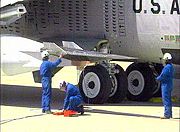
Unmanned aerial vehicle
An unmanned aerial vehicle , also known as a unmanned aircraft system , remotely piloted aircraft or unmanned aircraft, is a machine which functions either by the remote control of a navigator or pilot or autonomously, that is, as a self-directing entity...
experimental
Experimental aircraft
An experimental aircraft is an aircraft that has not yet been fully proven in flight. Often, this implies that new aerospace technologies are being tested on the aircraft, though the label is more broad....
hypersonic
Hypersonic
In aerodynamics, a hypersonic speed is one that is highly supersonic. Since the 1970s, the term has generally been assumed to refer to speeds of Mach 5 and above...
aircraft
Aircraft
An aircraft is a vehicle that is able to fly by gaining support from the air, or, in general, the atmosphere of a planet. An aircraft counters the force of gravity by using either static lift or by using the dynamic lift of an airfoil, or in a few cases the downward thrust from jet engines.Although...
with multiple planned scale
Scale (spatial)
Spatial scale provides a "shorthand" form for discussing relative lengths, areas, distances and sizes. A microclimate, for instance, is one which might occur in a mountain valley or near a lakeshore, whereas a megatrend is one which involves the whole planet....
variations meant to test various aspects of hypersonic
Hypersonic
In aerodynamics, a hypersonic speed is one that is highly supersonic. Since the 1970s, the term has generally been assumed to refer to speeds of Mach 5 and above...
flight. It was part of NASA
NASA
The National Aeronautics and Space Administration is the agency of the United States government that is responsible for the nation's civilian space program and for aeronautics and aerospace research...
's Hyper-X program. It has set several airspeed records for jet-propelled
Jet propulsion
Jet propulsion is motion produced by passing a jet of fluid in the opposite direction to the direction of motion. By conservation of momentum, the moving body is propelled in the opposite direction to the jet....
aircraft.
A winged booster rocket with the X-43 itself at the tip, called a "stack", is launched from a carrier plane. After the booster rocket (a modified first stage of the Pegasus rocket
Pegasus rocket
The Pegasus rocket is a winged space launch vehicle capable of carrying small, unmanned payloads into low Earth orbit. It is air-launched, as part of an expendable launch system developed by Orbital Sciences Corporation . Three main stages burning solid propellant provide the thrust...
) brings the stack to the target speed and altitude, it is discarded, and the X-43 flies free using its own engine, a scramjet
Scramjet
A scramjet is a variant of a ramjet airbreathing jet engine in which combustion takes place in supersonic airflow...
.
Development
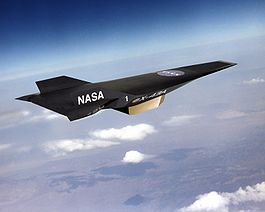
Speed
In kinematics, the speed of an object is the magnitude of its velocity ; it is thus a scalar quantity. The average speed of an object in an interval of time is the distance traveled by the object divided by the duration of the interval; the instantaneous speed is the limit of the average speed as...
s greater than Mach
Mach number
Mach number is the speed of an object moving through air, or any other fluid substance, divided by the speed of sound as it is in that substance for its particular physical conditions, including those of temperature and pressure...
7, about 8,050 km/h at altitude
Altitude
Altitude or height is defined based on the context in which it is used . As a general definition, altitude is a distance measurement, usually in the vertical or "up" direction, between a reference datum and a point or object. The reference datum also often varies according to the context...
s of 30,000 m or more. The X-43A is a single-use vehicle and is designed to crash into the ocean without recovery. Three of them have been built: the first was destroyed; the other two have successfully flown, with the scramjet operating for approximately 10 seconds, followed by a 10 minute glide and intentional crash.
The first flight in June 2001 failed when the stack spun out of control about 11 seconds after the drop from the B-52 carrier plane. It was destroyed by the Range Safety Officer
Range Safety Officer
In the field of rocketry, Range Safety Officer is a generic term referring to an individual who monitors the performance of rockets in flight, and who is responsible for their remote destruction if it should be judged that they pose a hazard...
, and it crashed into the Pacific Ocean. NASA attributed the crash to several inaccuracies in data modeling for this test, which led to an inadequate control system for the particular Pegasus used.
The X-43A's successful second flight made it the fastest free flying air-breathing aircraft in the world.
The third flight of the X-43A set a new speed record of 12,144 km/h (7,546 mph), or Mach 9.8, on November 16, 2004. It was boosted by a modified Pegasus rocket which was launched from a B-52 at 13,157 meters (43,166 ft). After a free flight where the scramjet operated for about 10 seconds, the craft made a planned crash into the Pacific Ocean off the coast of southern California.
The most recent success in the X-plane series of aircraft until it was replaced by the X-51
Boeing X-51
The Boeing X-51 is an unmanned scramjet demonstration aircraft for hypersonic flight testing. It successfully completed its first free-flight on 26 May 2010 and also achieved the longest duration flight at speeds over Mach 5.The X-51 Waverider program is run as a cooperative effort of the United...
, the X-43 was part of NASA's Hyper-X program, involving the American
United States
The United States of America is a federal constitutional republic comprising fifty states and a federal district...
space agency and contractors such as Boeing
Boeing
The Boeing Company is an American multinational aerospace and defense corporation, founded in 1916 by William E. Boeing in Seattle, Washington. Boeing has expanded over the years, merging with McDonnell Douglas in 1997. Boeing Corporate headquarters has been in Chicago, Illinois since 2001...
, MicroCraft Inc, Orbital Sciences Corporation
Orbital Sciences Corporation
Orbital Sciences Corporation is an American company which specializes in the manufacturing and launch of satellites. Its Launch Systems Group is heavily involved with missile defense launch systems...
and General Applied Science Laboratory
General Applied Science Laboratory
The General Applied Science Laboratory is an American aerospace company, known as a pioneer of hypersonic propulsion.-Description:The General Applied Science Laboratory was founded in 1956 by Antonio Ferri and became a developer and testing house for advanced propulsion systems.Another early...
(GASL). MicroCraft Inc., now known as ATK GASL, built the X-43A and its engine.
The Hyper-X Phase I is a NASA Aeronautics and Space Technology Enterprise program being conducted jointly by the Langley Research Center
Langley Research Center
Langley Research Center is the oldest of NASA's field centers, located in Hampton, Virginia, United States. It directly borders Poquoson, Virginia and Langley Air Force Base...
, Hampton, Virginia
Hampton, Virginia
Hampton is an independent city that is not part of any county in Southeast Virginia. Its population is 137,436. As one of the seven major cities that compose the Hampton Roads metropolitan area, it is on the southeastern end of the Virginia Peninsula. Located on the Hampton Roads Beltway, it hosts...
, and the Dryden Flight Research Center
Dryden Flight Research Center
The Dryden Flight Research Center , located inside Edwards Air Force Base, is an aeronautical research center operated by NASA. On March 26, 1976 it was named in honor of the late Hugh L. Dryden, a prominent aeronautical engineer who at the time of his death in 1965 was NASA's deputy administrator...
, Edwards, California
Edwards, California
Edwards is an unincorporated community in Kern County, California.It is located east-southeast of Mojave, at an elevation of 2356 feet ....
. Langley is the lead center and is responsible for hypersonic technology development. Dryden is responsible for flight research.
Phase I was a seven-year, approximately $230 million, program to flight-validate scramjet propulsion, hypersonic aerodynamics
Aerodynamics
Aerodynamics is a branch of dynamics concerned with studying the motion of air, particularly when it interacts with a moving object. Aerodynamics is a subfield of fluid dynamics and gas dynamics, with much theory shared between them. Aerodynamics is often used synonymously with gas dynamics, with...
and design methods.
Design
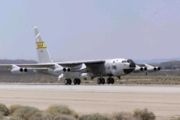
Length
In geometric measurements, length most commonly refers to the longest dimension of an object.In certain contexts, the term "length" is reserved for a certain dimension of an object along which the length is measured. For example it is possible to cut a length of a wire which is shorter than wire...
. The vehicle was a lifting body
Lifting body
A lifting body is a fixed-wing aircraft configuration in which the body itself produces lift. In contrast to a flying wing, which is a wing with minimal or no conventional fuselage, a lifting body can be thought of as a fuselage with little or no conventional wing...
design, where the body of the aircraft provides a significant amount of lift
Lift (force)
A fluid flowing past the surface of a body exerts a surface force on it. Lift is the component of this force that is perpendicular to the oncoming flow direction. It contrasts with the drag force, which is the component of the surface force parallel to the flow direction...
for flight, rather than relying on wing
Wing
A wing is an appendage with a surface that produces lift for flight or propulsion through the atmosphere, or through another gaseous or liquid fluid...
s. The aircraft weighed roughly 3,000 pounds
Pound (mass)
The pound or pound-mass is a unit of mass used in the Imperial, United States customary and other systems of measurement...
(about 1,300 kilogram
Kilogram
The kilogram or kilogramme , also known as the kilo, is the base unit of mass in the International System of Units and is defined as being equal to the mass of the International Prototype Kilogram , which is almost exactly equal to the mass of one liter of water...
s). The X-43A was designed to be fully controllable in high-speed flight, even when gliding
Gliding
Gliding is a recreational activity and competitive air sport in which pilots fly unpowered aircraft known as gliders or sailplanes using naturally occurring currents of rising air in the atmosphere to remain airborne. The word soaring is also used for the sport.Gliding as a sport began in the 1920s...
without propulsion
Air propulsion
Air propulsion is the generation of thrust during flight by an aircraft or a creature such as a bird, bat or insect.-Aircraft:An aircraft propulsion system must serve two purposes. First, the thrust from the propulsion system must balance the drag of the airplane when the airplane is cruising...
. However, the aircraft was not designed to land and be recovered. Test vehicles crashed into the Pacific Ocean
Pacific Ocean
The Pacific Ocean is the largest of the Earth's oceanic divisions. It extends from the Arctic in the north to the Southern Ocean in the south, bounded by Asia and Australia in the west, and the Americas in the east.At 165.2 million square kilometres in area, this largest division of the World...
when the test was over.
Traveling at Mach speeds produces a lot of heat due to the compression
Wave drag
In aeronautics, wave drag is a component of the drag on aircraft, blade tips and projectiles moving at transonic and supersonic speeds, due to the presence of shock waves. Wave drag is independent of viscous effects.- Overview :...
shock waves
Shock Waves
Shock Waves, , is a 1977 horror movie written and directed by Ken Wiederhorn...
involved in supersonic drag
Drag (physics)
In fluid dynamics, drag refers to forces which act on a solid object in the direction of the relative fluid flow velocity...
. At high Mach speeds, heat can become so intense that metal
Metal
A metal , is an element, compound, or alloy that is a good conductor of both electricity and heat. Metals are usually malleable and shiny, that is they reflect most of incident light...
portions of the airframe melt. The X-43A compensated for this by cycling water
Water
Water is a chemical substance with the chemical formula H2O. A water molecule contains one oxygen and two hydrogen atoms connected by covalent bonds. Water is a liquid at ambient conditions, but it often co-exists on Earth with its solid state, ice, and gaseous state . Water also exists in a...
behind the engine cowl and sidewall leading edges, cooling those surfaces. In tests, the water circulation was activated at about Mach 3. In the future, fuel may be cycled through such areas instead, much like what is currently done in many liquid-fuel rocket nozzles and high speed planes such as the SR-71.
Engine

Combustion
Combustion or burning is the sequence of exothermic chemical reactions between a fuel and an oxidant accompanied by the production of heat and conversion of chemical species. The release of heat can result in the production of light in the form of either glowing or a flame...
ramjet
Ramjet
A ramjet, sometimes referred to as a stovepipe jet, or an athodyd, is a form of airbreathing jet engine using the engine's forward motion to compress incoming air, without a rotary compressor. Ramjets cannot produce thrust at zero airspeed and thus cannot move an aircraft from a standstill...
, or "scramjet", an engine variation where external combustion takes place within air that is flowing at supersonic speeds. The X-43A's developers designed the aircraft's airframe to positively affect propulsion
Air propulsion
Air propulsion is the generation of thrust during flight by an aircraft or a creature such as a bird, bat or insect.-Aircraft:An aircraft propulsion system must serve two purposes. First, the thrust from the propulsion system must balance the drag of the airplane when the airplane is cruising...
, just as it affects aerodynamics
Aerodynamics
Aerodynamics is a branch of dynamics concerned with studying the motion of air, particularly when it interacts with a moving object. Aerodynamics is a subfield of fluid dynamics and gas dynamics, with much theory shared between them. Aerodynamics is often used synonymously with gas dynamics, with...
: in this design, the forebody is a part of the intake airflow, while the aft section functions as a nozzle.
The engine of the X-43A was primarily fueled with hydrogen
Hydrogen
Hydrogen is the chemical element with atomic number 1. It is represented by the symbol H. With an average atomic weight of , hydrogen is the lightest and most abundant chemical element, constituting roughly 75% of the Universe's chemical elemental mass. Stars in the main sequence are mainly...
. In the successful test, about two pounds (or roughly one kilogram) of the fuel was used. Unlike rockets, scramjet-powered vehicles do not carry oxygen onboard for fueling the engine. Removing the need to carry oxygen significantly reduces the vehicle's size and weight. In the future, such lighter vehicles could bring heavier payloads into space
Outer space
Outer space is the void that exists between celestial bodies, including the Earth. It is not completely empty, but consists of a hard vacuum containing a low density of particles: predominantly a plasma of hydrogen and helium, as well as electromagnetic radiation, magnetic fields, and neutrinos....
or carry payloads of the same weight much more efficiently.
Scramjets only operate at speeds in the range of Mach 4.5 or higher, so rockets or other jet engines are required to initially boost scramjet-powered aircraft to this base velocity. In the case of the X-43A, the aircraft was accelerated to high speed with a Pegasus rocket launched from a converted Boeing B-52 Stratofortress bomber. The combined X-43A/Pegasus vehicle was referred to as the "stack" by the program's team members.
The engines in the X-43A test vehicles were specifically designed for a certain speed range, only able to compress and ignite the fuel-air mixture when the incoming airflow is moving as expected. The first two X-43A aircraft were intended for flight at approximately Mach 7, while the third flew at nearly Mach 10.
Testing
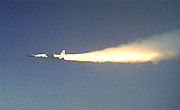
_mach_7_computational_fluid_dynamic_(cfd).jpg)
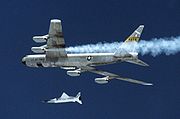
Transonic
Transonic speed is an aeronautics term referring to the condition of flight in which a range of velocities of airflow exist surrounding and flowing past an air vehicle or an airfoil that are concurrently below, at, and above the speed of sound in the range of Mach 0.8 to 1.2, i.e. 600–900 mph...
, eventually leading to the failure of the rocket's starboard elevon
Elevon
Elevons are aircraft control surfaces that combine the functions of the elevator and the aileron , hence the name. They are frequently used on tailless aircraft such as flying wings. An elevon that is not part of the main wing, but instead is a separate tail surface, is a stabilator...
. This caused the rocket to deviate significantly from the planned course, so the stack was destroyed by onboard explosives as a safety precaution. An investigation into the incident stated that imprecise information about the capabilities of the rocket as well as its flight environment contributed to the accident, though no single factor could ultimately be blamed for the failure.
In the second test in March 2004, the Pegasus fired successfully and released the test vehicle at an altitude of about 29000 metres (95,144.4 ft). After separation, the engine's air intake was opened, the engine ignited, and the aircraft then accelerated away from the rocket reaching mach 6.83. Fuel was flowing to the engine for eleven seconds, a time in which the aircraft traveled more than 24 km. After burnout, controllers were still able to maneuver the vehicle and manipulate the flight controls for several minutes as the aircraft was slowed down by wind resistance and took a long dive into the Pacific. Peak speed was at burnout of the Pegasus but the scramjet engine did accelerate the vehicle in climbing flight, after a small drop in speed following separation.
NASA flew a third version of the X-43A on November 16, 2004, achieving/maintaining a speed of Mach 9.68 at about 34000 metres (111,548.6 ft) altitude
and further testing the ability of the vehicle to withstand the heat loads involved.
Future of the scramjet
After the X-43 tests in 2004, NASA Dryden engineers said that they expected all of their efforts to culminate in the production of a two-stage-to-orbit crewed Vehicle in about 20 years. The scientists expressed much doubt that there would be a Single Stage to Orbit crewed vehicle like the National Aerospace Plane (NASP) in the foreseeable future, also known as the "Orient Express", that would take off from an ordinary airport runway.- In January 2006 USAF announced the Force Application and Launch from Continental United States or FALCON Scramjet reusable missile.
- In March 2006, it was announced that the Air Force Research Laboratory (AFRL) supersonic combustion scramjet "Waverider" flight test vehicle has been designated as X-51A. The USAF Boeing X-51Boeing X-51The Boeing X-51 is an unmanned scramjet demonstration aircraft for hypersonic flight testing. It successfully completed its first free-flight on 26 May 2010 and also achieved the longest duration flight at speeds over Mach 5.The X-51 Waverider program is run as a cooperative effort of the United...
Scramjet-powered Waverider was first flown on May 26, 2010. It was dropped from a B-52.
Variants
Other X-43 vehicles were designed, but appear to have been suspended. They were expected to have the same basic body design as the X-43A, though the aircraft were expected to be moderately to significantly larger in size.X-43B
The X-43B, was expected to be a full-size vehicle, incorporating a turbine-based combined cycle (TBCC) engine or a rocket-based combined cycleRocket-based combined cycle
The RBCC, or Rocket-Based Combined Cycle, is one of the two types of propulsion systems that may be used in the Boeing X-43 experimental aircraft....
(RBCC) ISTAR engine. Jet turbines or rockets would initially propel the vehicle to supersonic speed. A ramjet
Ramjet
A ramjet, sometimes referred to as a stovepipe jet, or an athodyd, is a form of airbreathing jet engine using the engine's forward motion to compress incoming air, without a rotary compressor. Ramjets cannot produce thrust at zero airspeed and thus cannot move an aircraft from a standstill...
might take over starting at Mach 2.5, with the engine converting to a scramjet configuration at approximately Mach 5.
X-43C
The X-43C would have been somewhat larger than the X-43A and was expected to test the viability of hydrocarbon fuel, possibly with the HyTech engine. While most scramjet designs have used hydrogen for fuel, HyTech runs with conventional kerosene-type hydrocarbon fuels, which are more practical for support of operational vehicles. The building of a full-scale engine was planned which would use its own fuel for cooling. The engine cooling system would have acted as a chemical reactor by breaking long-chain hydrocarbons into short-chain hydrocarbons for a rapid burn.The X-43C was indefinitely suspended in March 2004. The linked story reports the project's indefinite suspension and the appearance of Rear Admiral Craig E. Steidle
Craig E. Steidle
Admiral Craig E. Steidle, USN, Ret., served as the first Associate Administrator of the Office of Exploration Systems at NASA , an organization formed to implement NASA's human exploration of the solar system as announced in the Vision for Space Exploration...
before a House Space and Aeronautics subcommittee hearing on March 18, 2004. In mid-2005 the X-43C appeared to be funded through the end of the year.
X-43D
The X-43D would have been almost identical to the X-43A, but expanding the speed envelope to approximately MachMach number
Mach number is the speed of an object moving through air, or any other fluid substance, divided by the speed of sound as it is in that substance for its particular physical conditions, including those of temperature and pressure...
15. As of September 2007, only a feasibility study had been conducted by Donald B. Johnson of Boeing
Boeing
The Boeing Company is an American multinational aerospace and defense corporation, founded in 1916 by William E. Boeing in Seattle, Washington. Boeing has expanded over the years, merging with McDonnell Douglas in 1997. Boeing Corporate headquarters has been in Chicago, Illinois since 2001...
and Jeffrey S. Robinson of NASA's Langley Research Center
Langley Research Center
Langley Research Center is the oldest of NASA's field centers, located in Hampton, Virginia, United States. It directly borders Poquoson, Virginia and Langley Air Force Base...
. According to the introduction of the study, "The purpose of the X-43D is to gather high Mach number flight environment and engine operability information which is difficult, if not impossible, to gather on the ground."

